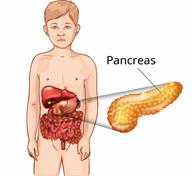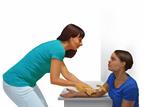Type 1 Diabetes Mellitus, Diagnosis, Pediatric

Type 1 diabetes mellitus, or type 1 diabetes, is a long-term (chronic) disease. It happens when the cells in the pancreas that make a hormone called insulin are destroyed.
Normally, insulin lets blood sugar (glucose) enter cells in your body. This provides energy. If your child has type 1 diabetes, glucose cannot get into cells. It builds up in the blood instead. This causes high blood glucose (hyperglycemia).
There is no cure for type 1 diabetes. Treatment can help you and your child manage their condition.
What are the causes?
The exact cause of type 1 diabetes is not known.
What increases the risk?
Your child may be more likely to have type 1 diabetes if a family member has it as well. They may also be more at risk if:
They have a gene for type 1 diabetes that was passed from parent to child (inherited).
They have an autoimmune disorder. This means that their body's disease-fighting system (immune system) is attacking itself.
They started having solid foods before age 4 months or after age 6 months.
They have been exposed to certain viruses.
They have cystic fibrosis.
They live in an area with cold weather.
What are the signs or symptoms?
Symptoms may begin slowly over days or weeks. They may also start all of a sudden. Symptoms may include:
Increased thirst or hunger.
Needing to pee (urinate) more often or peeing more at night. Your child may wet their bed.
Sudden weight changes that cannot be explained.
Irritability or changes in behavior.
Less common symptoms include:
How is this diagnosed?

Type 1 diabetes is diagnosed based on your child's symptoms and medical history, a physical exam, and your child's blood glucose level. The blood glucose may be checked with:
A fasting blood glucose (FBG) test. Your child will not be allowed to eat (they will fast) for 8 hours or more before a blood sample is taken.
A random blood glucose test. This test checks your child's blood glucose at any time of day no matter when they last ate.
A hemoglobin A1C (A1C) blood test. This shows what your child's blood glucose levels have been over the last 2–3 months.
Your child may be diagnosed with type 1 diabetes if:
Their FBG level is 126 mg/dL (7 mmol/L) or higher.
Their random blood glucose level is 200 mg/dL (11.1 mmol/L) or higher.
Their A1C level is 6.5% or higher.
These blood tests may be done more than once. Your child may also need urine tests or other blood tests.
If your child has symptoms of diabetes, they may be looked at in the emergency room. Your child may need to stay at the hospital at the start of treatment.
How is this treated?
You and your child may work with an expert called a pediatric endocrinologist to find ways to manage their diabetes. You should also follow instructions from your child's health care provider. You may need to:
Give insulin every day. This helps keep your child's blood glucose levels in the right range.
Check your child's blood glucose as often as told.
- Help your child make diet and lifestyle changes. Your child may need to:
Follow a nutrition plan that has been made just for them by a dietitian.
Get regular exercise. Check your child's blood glucose before and after they exercise. Your child may need to eat a snack before they exercise. This helps prevent low blood glucose.
Give medicines to help prevent problems from diabetes.
Make a written care plan (504 plan) for managing your child's diabetes at school.
Have your child's blood tested every year to check for conditions that are linked to type 1 diabetes.
The provider will set treatment goals that are right for your child. These will be based on your child's age and other conditions they have.
Follow these instructions at home:
Questions to ask your child's health care provider
You may want to ask the provider:
Do my child and I need to meet with a certified diabetes care and education specialist?
Where can I find a support group for children with diabetes?
What equipment will I need to manage my child's diabetes at home?
What medicines does my child need, and when should I give them?
How often should I check my child's blood glucose?
What number can I call if I have questions?
When is my child's next appointment?
General instructions
Give over-the-counter and prescription medicines only as told by your child's provider.
Keep all follow-up visits. Your child will need to get regular blood tests to make sure treatment is working. The provider may adjust your child's medicines based on the test results.
-
-
-
International Diabetes Federation (IDF):
idf.org
Contact a health care provider if:
-
Your child's blood glucose is out of the healthy range.
-
Your child has been sick or has had a fever for 2 days or more, and they are not getting better.
-
Your child cannot eat or drink.
-
Your child has nausea or vomiting.
-
Your child has diarrhea.
-
Your child's blood glucose is below 54 mg/dL (3 mmol/L).
-
Your child becomes confused or has trouble thinking clearly.
-
Your child has trouble breathing.
These symptoms may be an emergency. Do not wait to see if the symptoms will go away. Get help right away. Call 911.
This information is not intended to replace advice given to you by your health care provider. Make sure you discuss any questions you have with your health care provider.

 Type 1 diabetes is diagnosed based on your child's symptoms and medical history, a physical exam, and your child's blood glucose level. The blood glucose may be checked with:
Type 1 diabetes is diagnosed based on your child's symptoms and medical history, a physical exam, and your child's blood glucose level. The blood glucose may be checked with: